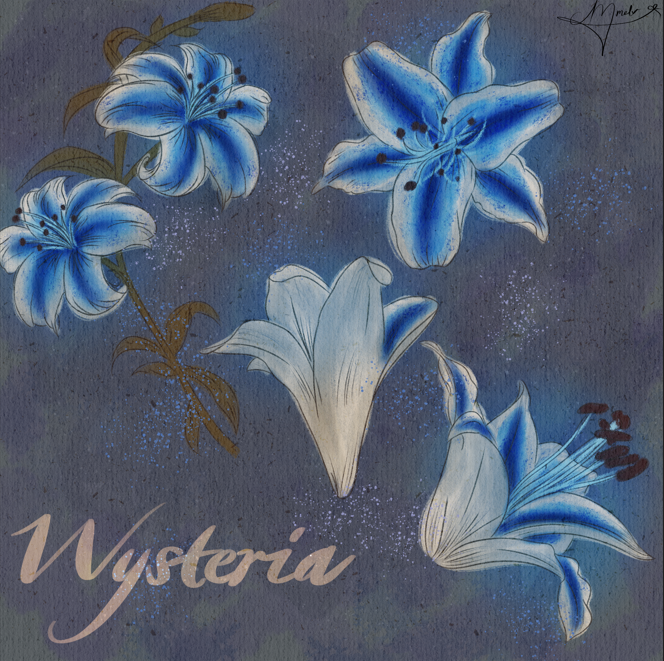・・・・・・・・・・
Wysteria and its Impact on the Human Brain
Exploring the Neurotoxic Potential of the Blue
・・・・・・・・・・

・・・・・・・・・・
Wysteria Flower Document | Forums
Wysteria: Long-Term and Near-Permanent Effects
Wysteria, a plant within the nightshade family, is a highly toxic flower with potent neurotoxic properties. Composed of various deadly components, its long-term and near-permanent effects on those who ingest or are exposed to it are profound, irreversible, and can persist long after the initial poisoning event.
Toxic Properties and Immediate Effects
Wysteria’s foliage and bulb are laced with tropane alkaloids such as atropine, scopolamine (hyoscine), and hyoscyamine. These toxins work by disrupting the parasympathetic nervous system, responsible for controlling involuntary functions such as heart rate, digestion, and respiration. Alcohol can exacerbate the toxicity, leading to central nervous system depression and neurological symptoms.
The immediate symptoms of exposure include, but not limited to:
- Visual & auditory hallucinations
- Delirium
- Blurred vision
- Accelerated heart rate
- Confusion
- Nausea & vomiting
- Paranoia
- Fear
- Extreme sadness
- Disorientation
- Tremors
- Incoherent speech
- Dilated pupils
- Sweating
- Irregular breathing
- Brain fog
If the individual has ingested any part of the plant, their symptoms can include, but not limited to:
- Skin rash or hives
- Severe headache
- Accelerated heart rate
- Extreme dryness in the mouth and throat
- Nausea & vomiting
- Itchiness
- Sore muscles or joints
- Difficulty swallowing
- Wheezing
- Diarrhea
- Abdominal pain
- Brain fog
- Anaphylaxis in severe cases
- Fever
- Ileus
- Heart rhythm disturbances
- Tachycardia
- Insomnia
Depending on how long a person has been exposed for (Including how frequent they come into contact with the plant), these symptoms escalate to severe neurological distress, including, but not limited to:
- Paralysis
- Convulsions
- Coma
- Eventually death, if not treated with an appropriate antidote.
Death from ingesting large amounts of the plant results from cardiac arrhythmias and respiratory failure.
Despite the severity of the symptoms, the long-term consequences of exposure to Wysteria are even more chilling. While some individuals may recover from the initial poisoning with medical intervention, frequent and long time exposures will have more adverse effects. The neurotoxic properties of the plant will wreak havoc on the brain and nervous system, often leading to permanent psychological and cognitive changes.
・・・・・・・・・・

・・・・・・・・・・
Cognitive and Psychological Decline
Wysteria’s alkaloids interfere with neurotransmitter balance in the brain, particularly acetylcholine, a neurotransmitter that plays a crucial role in memory, learning, and general cognitive function. Over time, repeated exposure or chronic ingestion of Wysteria can lead to long-lasting cognitive impairments, including memory loss, difficulty concentrating, and a gradual erosion of higher brain functions. Neurodegeneration can be progressive, as the plant’s toxins accumulate and damage neural circuits, leading to an irreversible decline in cognitive abilities. In severe cases, this results in conditions akin to dementia or permanent intellectual disability.
The psychological effects of Wysteria can also be profound and unpredictable. Many who survive an initial contact find themselves experiencing recurring symptoms of anxiety, paranoia, and hallucinations. These individuals may swing between manic excitement and depressive states, and long-term exposure may bring persistent psychosis, with periods of intense delirium and a loss of connection with reality. This psychological deterioration often worsens over time, with bouts of violent behavior, disorientation, and aggressive outbursts.
Neurological and Physical Damage
The neurotoxic effects of Wysteria are not limited to cognitive decline; they can also manifest as permanent physical damage. The plant’s toxins disrupt the central and peripheral nervous systems, impairing motor control and causing persistent tremors, involuntary movements, and paralysis. This motor dysfunction may not be immediately apparent but can gradually worsen, leading to the inability to perform everyday tasks or control bodily movements.
In some cases, prolonged exposure to Wysteria’s toxins can result in irreversible damage to the heart and circulatory system. The alkaloids in Wysteria interfere with the normal function of the cholinergic system, potentially causing heart rhythm disturbances, bradycardia (slower than normal heart rate), and in some cases, fatal arrhythmias. The continuous suppression of the parasympathetic nervous system leaves the body vulnerable to cardiovascular collapse and respiratory failure.
Even small amounts of Wysteria can severely affect the digestive and excretory systems, with lasting consequences. Chronic exposure often leads to gastrointestinal disorders such as:
- Severe constipation
- Ileus (intestinal blockage)
- Urinary retention.
The disruption of autonomic control may also cause persistent problems with bowel function, resulting in long-term discomfort and difficulty.
Psychiatric and Psychological Disturbances
The effects on the psyche of those who experience Wysteria poisoning can be devastating. The combination of hallucinations, delirium, and the profound anticholinergic properties of the plant often leaves survivors with permanent emotional and psychological scars. Many individuals experience long-lasting fear, confusion, and a disjointed perception of reality.
This confusion can morph into chronic anxiety, PTSD, or even full-blown psychosis.
Perhaps most terrifyingly, the toll of Wysteria poisoning can continue long after physical recovery. Individuals may struggle to separate dreams from reality, and their minds may become increasingly fragmented. Social interactions and personal relationships often suffer, as the individual finds it increasingly difficult to trust others or remain grounded in reality.
Unpredictable and Dangerous Long-Term Effects
Wysteria’s impact on human health and psychology is highly unpredictable. Genetic factors, existing health conditions, and previous exposure to toxic substances all play a role in determining the severity and duration of its effects. For some individuals, a single dose may lead to life-long neurological disorders or even death, while others may endure less severe symptoms but continue to suffer from ongoing cognitive impairments.
The plant’s unpredictable nature also means that repeated exposure to even small amounts, such as through contaminated honey made by bees that feed on its nectar, can lead to gradual and permanent damage. Long-term ingestion of such contaminated substances can result in chronic poisoning and an accelerating decline in both physical and mental health.
Conclusions
The Wysteria plant has become a symbol of persistent threat to those who encounter it, with both immediate and long-term consequences. The plant’s toxic properties, which disrupt the nervous system and cognitive function, can lead to permanent damage that may never fully heal, resulting in ongoing psychological distress, neurological impairment, and, ultimately, a dramatically diminished quality of life. Its long-term effects on the brain, body, and mind, compounded by its unpredictable nature, make Wysteria a particularly dangerous plant in the realm of toxic flora.
・・・・・・・・・・

・・・・・・・・・・
[!] For any questions or further explanations on any of these details, please ask in the comments under this post. [!]
[!] You MUST roleplay these symptoms if your character comes into contact with the flowers. You must also get your character medical attention. DO NOT FAILRP. [!]
[!] Characters are NOT allowed to know these details from this post ICLY. This post is an aid on how you should properly roleplay the effects. [!]
[!] Characters are supposed to be fearful, cautious, and avoidant of these flowers. [!]
・・・・・・・・・・
Written by : @mmelv & @Hexstrap
Photos by : @mmelv
Last edited: 4 months ago x 4


